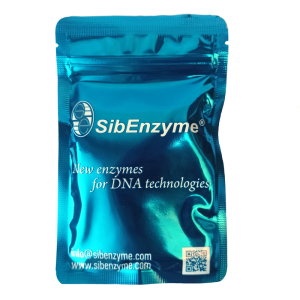Description
T4 polynucleotide Kinase catalyzes the transfer and exchange of Pi from the γ position of ATP to the 5` hydroxyl terminus of polynucleotides (double- and single-stranded DNA and RNA) and nucleoside 3`-monophosphates. The enzyme also catalyzes the removal of 3` – phosphoryl groups from 3` – phosphoril polynucleotides, deoxynucleoside 3` – monophosphates and deoxynucleoside 3` – diphosphates.
Applications:
– end-labeling DNA or RNA for probes and DNA sequencing;
– addition of 5` – phosphates to oligonucleotides to allow subsequent ligation;
– removal of 3` – phosphoril groups.
Source: Isolated from E.coli strain that carries the cloned Polynucleotide kinase gene from bacteriophage T4
Unit definition: T4 polynucleotide Kinase catalyzes the transfer and exchange of Pi from the γ position of ATP to the 5` hydroxyl terminus of polynucleotides (double- and single-stranded DNA and RNA) and nucleoside 3`-monophosphates. The enzyme also catalyzes the removal of 3` – phosphoryl groups from 3` – phosphoril polynucleotides, deoxynucleoside 3` – monophosphates and deoxynucleoside 3` – diphosphates.
Applications:
– end-labeling DNA or RNA for probes and DNA sequencing;
– addition of 5` – phosphates to oligonucleotides to allow subsequent ligation;
– removal of 3` – phosphoril groups.
Reaction buffer: SE-buffer polynucleotide kinase T4
Storage conditions: 10 mM Tris-HCl (pH 7.5); 50 mM NaCl; 0.1 mM EDTA; 1 mM DTT; 50% glycerol; Store at -20°C.
Quality control: The enzyme is purified free of contaminating endonucleases, exonucleases, phosphatases.
Supplied with: SE-buffer polynucleotide kinase T4
Optionally, you can purchase 10 mM adenosine-5′-triphosphate triphosphate (ATP), which is used as a phosphate group donor in the kinase reaction



